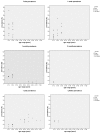Thoracic spine pain in the general population: prevalence, incidence and associated factors in children, adolescents and adults. A systematic review
- PMID: 19563667
- PMCID: PMC2720379
- DOI: 10.1186/1471-2474-10-77
Thoracic spine pain in the general population: prevalence, incidence and associated factors in children, adolescents and adults. A systematic review
Abstract
Background: Thoracic spine pain (TSP) is experienced across the lifespan by healthy individuals and is a common presentation in primary healthcare clinical practice. However, the epidemiological characteristics of TSP are not well documented compared to neck and low back pain. A rigorous evaluation of the prevalence, incidence, correlates and risk factors needs to be undertaken in order for epidemiologic data to be meaningfully used to develop evidence-based prevention and treatment recommendations for TSP.
Methods: A systematic review method was followed to report the evidence describing prevalence, incidence, associated factors and risk factors for TSP among the general population. Nine electronic databases were systematically searched to identify studies that reported either prevalence, incidence, associated factors (cross-sectional study) or risk factors (prospective study) for TSP in healthy children, adolescents or adults. Studies were evaluated for level of evidence and method quality.
Results: Of the 1389 studies identified in the literature, 33 met the inclusion criteria for this systematic review. The mean (SD) quality score (out of 15) for the included studies was 10.5 (2.0). TSP prevalence data ranged from 4.0-72.0% (point), 0.5-51.4% (7-day), 1.4-34.8% (1-month), 4.8-7.0% (3-month), 3.5-34.8% (1-year) and 15.6-19.5% (lifetime). TSP prevalence varied according to the operational definition of TSP. Prevalence for any TSP ranged from 0.5-23.0%, 15.8-34.8%, 15.0-27.5% and 12.0-31.2% for 7-day, 1-month, 1-year and lifetime periods, respectively. TSP associated with backpack use varied from 6.0-72.0% and 22.9-51.4% for point and 7-day periods, respectively. TSP interfering with school or leisure ranged from 3.5-9.7% for 1-year prevalence. Generally, studies reported a higher prevalence for TSP in child and adolescent populations, and particularly for females. The 1 month, 6 month, 1 year and 25 year incidences were 0-0.9%, 10.3%, 3.8-35.3% and 9.8% respectively. TSP was significantly associated with: concurrent musculoskeletal pain; growth and physical; lifestyle and social; backpack; postural; psychological; and environmental factors. Risk factors identified for TSP in adolescents included age (being older) and poorer mental health.
Conclusion: TSP is a common condition in the general population. While there is some evidence for biopsychosocial associations it is limited and further prospectively designed research is required to inform prevention and management strategies.
Figures


References
-
- Australian Acute Musculoskeletal Pain Guidelines Group . Evidence-based management of acute musculoskeletal pain. A guide for clinicians. Brisbane: Australian Academic Press. National Health and Medical Research Council (Australia); 2004. - PubMed
Publication types
MeSH terms
LinkOut - more resources
Full Text Sources
Medical
Miscellaneous

